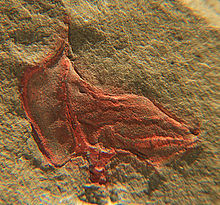| Stylophora Temporal range:
| |
|---|---|

| |
| Cothurnocystis elizae | |
| Scientific classification | |
| Domain: | Eukaryota |
| Kingdom: | Animalia |
| Superphylum: | Deuterostomia |
| Clade: | Ambulacraria |
| Phylum: | Echinodermata |
| Class: | †Stylophora Gill & Caster, 1960 |
| Orders | |
The stylophorans are an extinct, possibly polyphyletic group allied to the Paleozoic Era echinoderms, comprising the prehistoric cornutes and mitrates.[2] It is synonymous with the subphylum Calcichordata. Their unusual appearances have led to a variety of very different reconstructions of their anatomy, how they lived, and their relationships to other organisms.
Stylophorans have played a major role in debates over the origin of chordates, as under the calcichordate hypothesis they were interpreted as being stem-group chordates. However, multiple lines of evidence argue against the calcichordate hypothesis, and stylophorans are now widely agreed to belong to the echinoderm total group. Debate remains over whether they are stem-group echinoderms which predate the origin of radial symmetry, or highly modified descendants of radially symmetric echinoderms.
- ^ Geggel, Laura (22 February 2019). "480-Million-Year-Old Mystery Creature Finally Identified from Its Preserved Guts". LiveScience.
- ^ Lefebvre, B (2007). "Early Palaeozoic palaeobiogeography and palaeoecology of stylophoran echinoderms". Palaeogeography, Palaeoclimatology, Palaeoecology. 245 (1–2): 156–199. doi:10.1016/j.palaeo.2006.02.021.